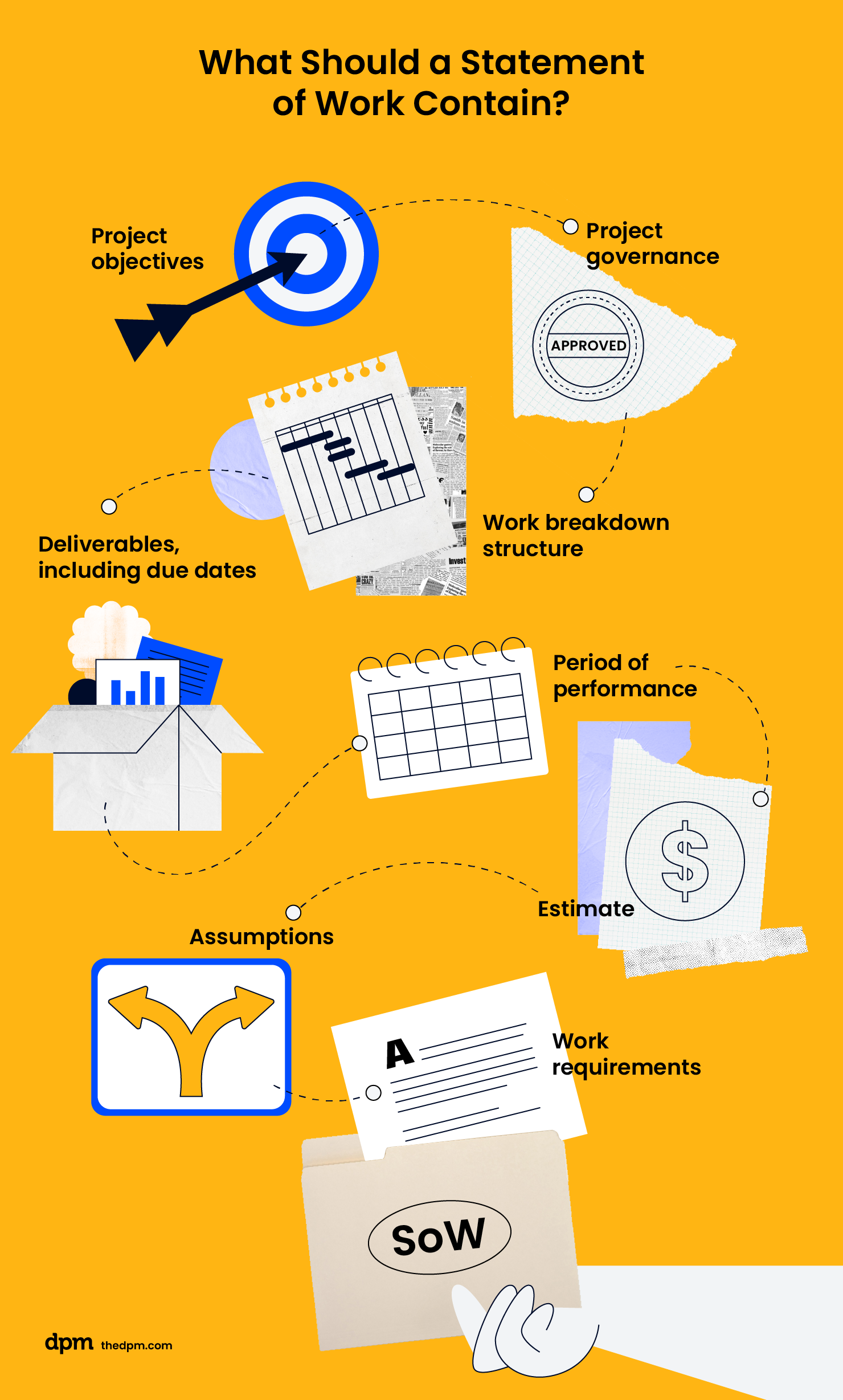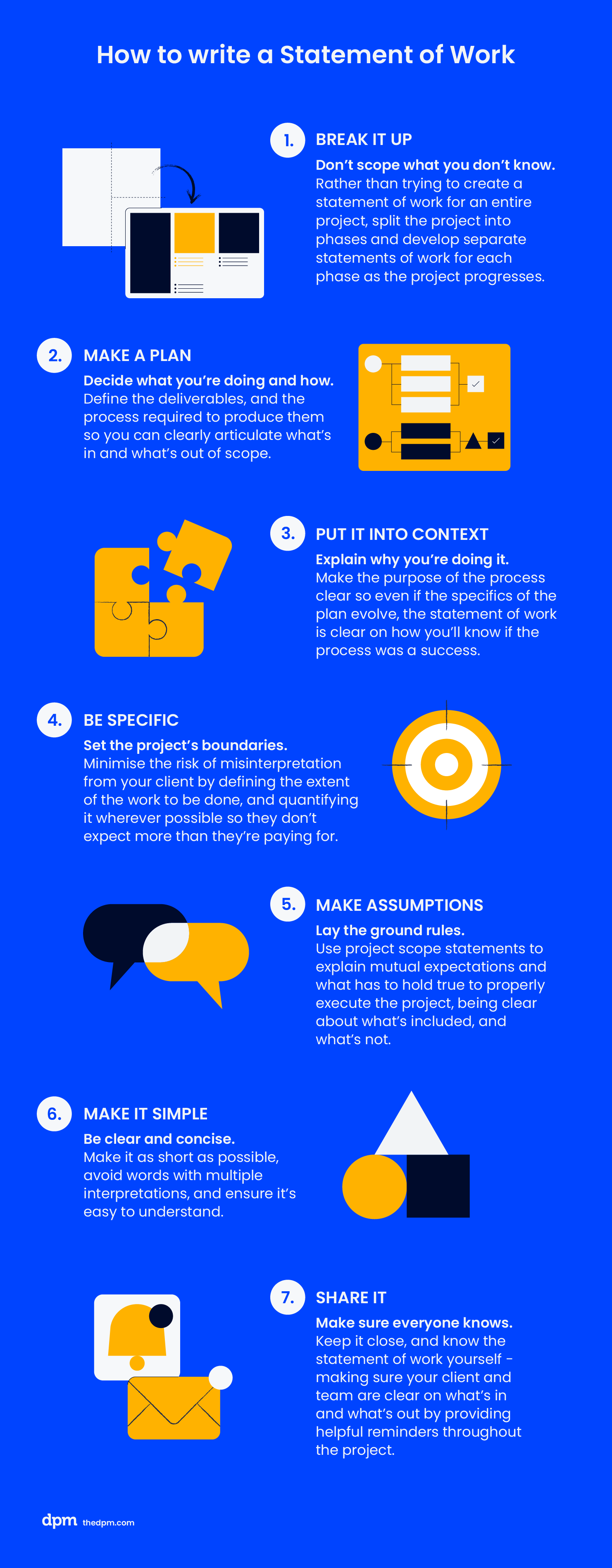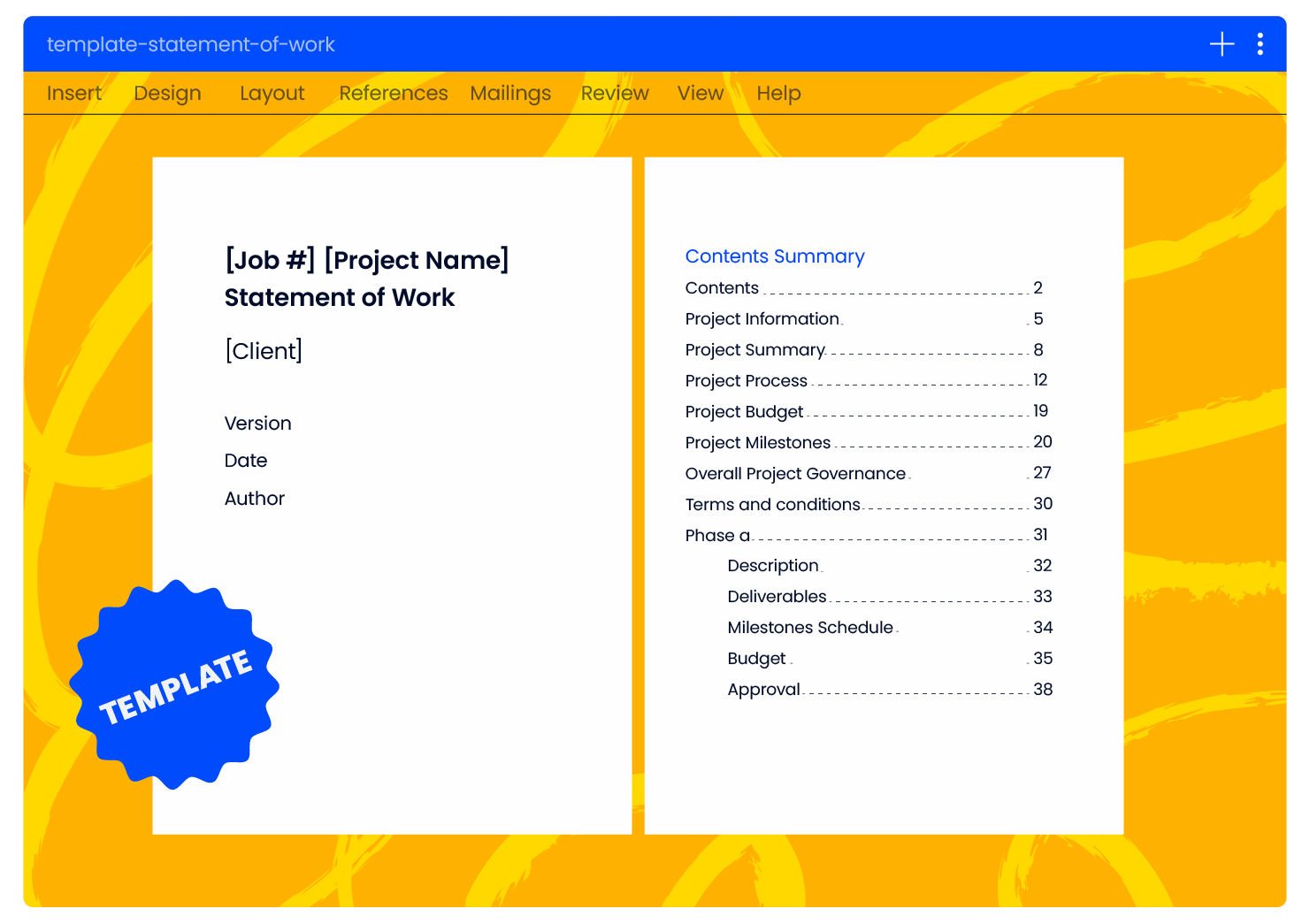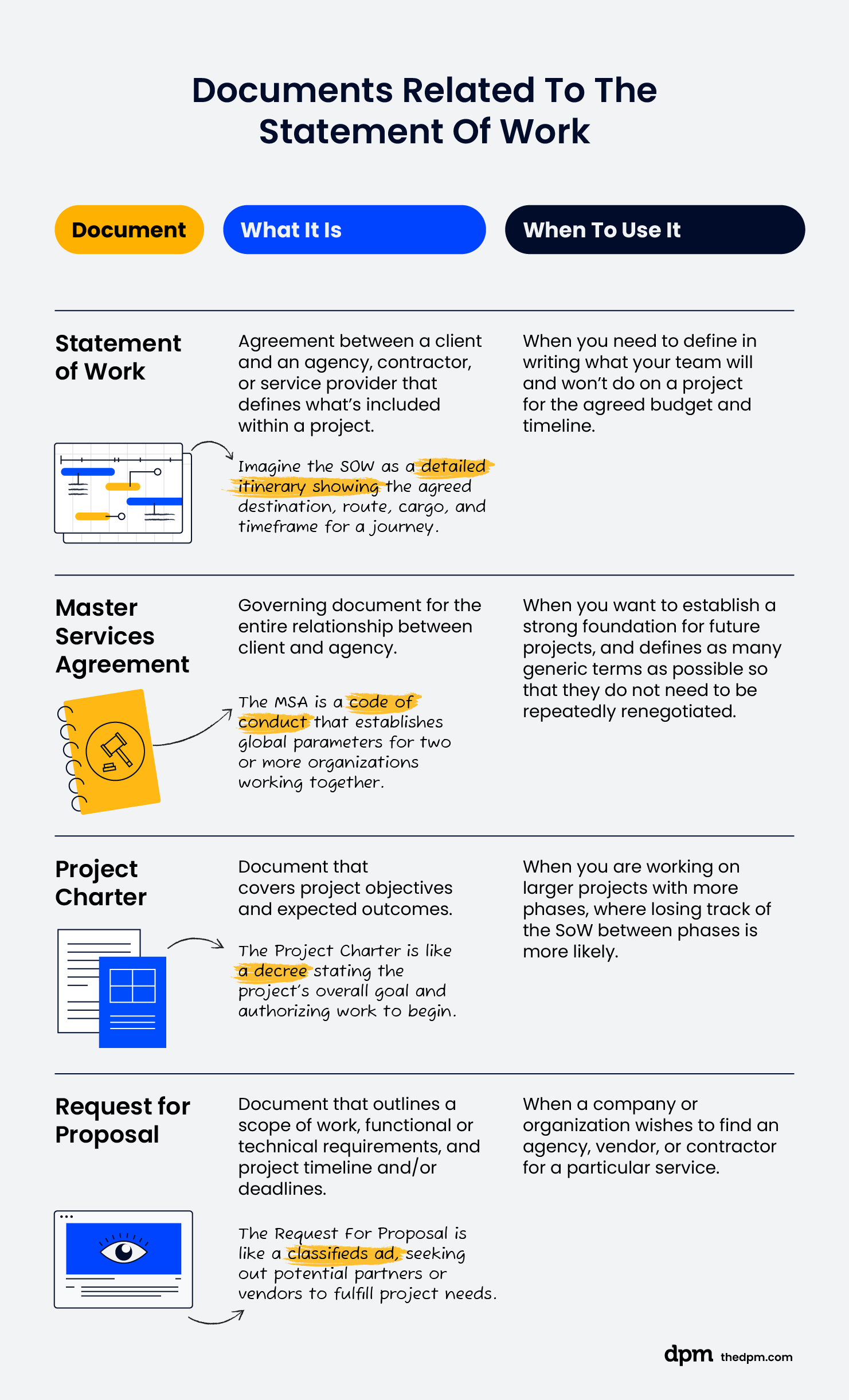An effective statement of work can be the ultimate tool to head off trouble before it starts. It's the single source of truth that clarifies what you and your team are responsible for when delivering the project.
On the flip side, an unclear statement of work can mean delays, extra work, and reduced profitability.
Here's how to craft one that sets clear expectations, protects you and your team, and maximizes everyone's chance for success.
What is a Statement of Work?
In project management, a statement of work (SoW) is an agreement between a client and an agency, contractor, or service provider that defines what’s included within a project.
A well-written SoW clearly defines what your team will and won’t do on a project—saving you from painful client negotiations and protecting your timeline and the bottom line.
PS: Some people refer to the statement of work as a scope of work instead. Po-tay-to, po-tah-to.
Here's a very un-serious explanation:
What Should a Statement of Work Contain?
The SoW is the project contract that sets and aligns expectations. It summarizes the purpose of the project and defines deliverables, standards, criteria, and requirements for each project phase.
If you’ve already created a project plan or timeline and a project estimate, then the SoW is the icing on the cake—it’s got the juicy details to tie everything together.

Statement of Work Components
So what should a SoW contain? What are the bits of a SoW that are important? What’s redundant?
At a minimum, the SoW should clearly detail:
- Project objectives: purpose statement, ie. why the project is happening and what it will achieve
- Project governance: who has approval to do what
- Work breakdown structure (WBS): how the project will be completed, what approach will be taken, and the specific tasks and phases that will be completed
- Deliverables, including due dates: what will be produced and by when
- Period of performance: when the project will be delivered, along with the amount of time needed, approximate start date and end date, and a list of milestones
- Estimate: project pricing, along with a payment schedule
- Assumptions: what is and isn’t included in the project scope, including acceptance criteria, i.e. what is and isn’t acceptable to deliver
- Work requirements: any other special requirements and specifics about how the project is to be completed, such as specific approaches or project management tools. For software development projects, include functional requirements.
Pitfalls in Creating a Statement of Work
While creating a SoW might sound reasonably simple, you’ll need to watch out for some common pitfalls:
Not Enough Details
If the work statement is too vague, too broad, or too generic, it can leave room for multiple interpretations. This can create misunderstandings later in a project.
Too Many Details!
If the SoW is too detailed, it can artificially constrain the project. You may end up doing work that’s not truly needed, simply because you said you would.
Imagine Goldilocks is building your SoW... it needs to be juuust right.
How to Write a Statement of Work
Keep these tips and tricks in mind when crafting a SoW:

1. Break it Up
Don’t scope what you don’t know. Rather than trying to create a SoW for an entire project, split the project into phases, and develop separate SoWs for each phase as the project progresses.
2. Make a Plan
Decide what you’re doing and how. Define the deliverables, and the process required to produce them so you can clearly articulate what’s in and what’s out of the project scope.
3. Put it into Context
Explain why you’re doing the project. Even if the specifics of the plan evolve, the SoW should help you to assess whether the project was a success.
4. Be Specific
Set the project’s boundaries. Minimize the risk of misinterpretation from your client by defining the extent of the work to do and quantifying it wherever possible so the client doesn’t expect more than you’ve budgeted.
5. Make Assumptions Clear
Lay the ground rules. Use project scope statements to explain mutual expectations and what has to hold true for your team to properly execute the project.
6. Simplify
Be clear and concise. Strike a balance between making the SoW as lean as possible while also carefully specifying the work to be done. Avoid words with multiple interpretations, and use plain language to ensure the SoW is easy to understand.
7. Share
As the project manager, you should know your SoW inside and out and be able to communicate its contents to your stakeholders. Make sure stakeholders have seen a copy of the SoW, and continue to refer back to the SoW throughout the project lifecycle. More on this later on!
Statement of Work Template & Example [Download]
Searching for SoW templates online yields countless results. The challenge is that many of these templates are confusing and contain much more than is typically needed for managing digital projects. The goal is to be able to produce a robust and flexible SoW quickly, with the appropriate level of detail.
Fortunately, we’ve got the template for you! Our digital project SoW template is fully detailed and ready to use. It helps answer the questions: “what should I include in my SoW?”, “how much detail do I need?”, and “where do I store project information?”

Instead of wasting time cobbling together something yourself, we’ve done the hard work for you. Our detailed SoW template is approximately 12 pages long (1000 words) and is available in a format that's compatible with Microsoft Word & Google Docs for you to adapt as you need. The template is unbranded and uses generic styling to make it easy for you to edit content and brand it with your logo.
The template includes two parts. The first section outlines overarching project information, while the second section defines the details of each phase. You can add subsequent phases if your project requires them.
The SoW template includes the following sections:
- Contents
- Project Information
- Project Summary
- Project Process
- Project Budget
- Project Milestones
- Project Governance
- Terms and Conditions
- Phase Details
- Deliverable Descriptions
You can find a pre-made statement of work template (plus a filled-in example!) in the DPM Membership templates library. I’ve included prompts to help you fill out each section, and because SoW documents are such a massive undertaking, I’ve also put together a complete sample SoW for reference.
Find more project management templates here.
How To Use a Statement of Work
So you’ve finally got your SoW approved—now the real fun of keeping the project on track begins. If you don’t stick to the SoW, it’s highly likely you’ll end up:
- Not quite delivering what was desired
- Late delivering on your project goals
- Running over your budget
So how do you stick to the plan and keep your SoW on track?
1. Know Your SoW Inside & Out

You need to know this thing better than anyone.
I mean, how embarrassing is it if the client brings up something that you’ve written in the SoW but forgotten about? That's right, SoW embarrassing.
Bad joke? Okay, moving on.
Keep a copy of your SoW on hand. I recommend uploading it to your project management software for central access but, if you're a caveperson, you can print it out, too.
Whatever you do, have the SoW available when you’re on a call or in a meeting; whenever it’s in question, everyone will look to you for answers.
That being said, you need to...
2. Get Your Team on Board

It’s not good enough for you alone to know the SoW—you need to evangelize the SoW with your team to guard against the risk of scope creep.
Even if your team was involved in architecting the SoW, it’s bound to have changed and evolved since project inception. Make sure team members understand:
- Project activities
- Deliverables
- Assumptions
- What success looks like
Circulate the SoW, print copies, stick it on the walls of your war room, or get it tattooed on your body. Just make it visible and ensure everyone's read up.
The last thing you want is for a team member to agree to an ad hoc client request (that isn’t part of the execution plan) or overlook a key contract requirement. Therefore, you need to...
3. Get Buy-In From Your Team

Let's get something clear: Blind agreement is a bad thing.
Take the time to go through the finalized plan with your project team and get their real buy-in. If they think that something doesn’t make sense or isn’t ultimately going to drive the success of the project, hash it out before you send everyone off to work.
If you get it clear from the start, you reduce the number of check-ins necessary along the way, allowing your team to work with collaboration tools on their own time.
There’s never value in doing work simply because the SoW dictates it. If it’s good for the project, then you should be able to make a case to the client to change it, which means you have to...
4. Keep Your SoW Top of Mind

Don’t be afraid of bringing up the SoW in your client meetings—in fact, a review of the SoW should be a standing agenda item. Discuss if the SoW is still valid and whether things are going according to plan.
If there are things that need to be adjusted, understand the reasons why, make the changes, and ensure everyone is aware of them.
But remember: Don't succumb to every new request and idea. The SoW is there to set boundaries on your project scope, so you don't fall victim to project management's Bogeyman: Scope creep.
5. Watch Out for Scope Creep

Scope creep happens when the project scope begins to grow, seemingly sneakily. Typically, it’s when a request starts out as one thing, then slowly morphs into a much bigger project that bites chunks out of your profits.
It sucks... but it happens honestly. Clients are full of (mostly) good ideas and, often, don't understand the schedule or budgetary implications of what they’re asking for.
In order to manage scope creep, you need to watch for, call out, and resolve the problem. When you see ad-hoc requests creep in, come back to your SoW. If you and the client agree it’s out of scope but they still want it done, you need to issue a change request (aka, an update to the SoW).
The change request should describe:
- The change from the original SoW
- How you’re going to execute the request
- The budget and timeline implications
6. Be Vigilant from the Beginning

Projects that go off the rails often do so in the early stages of the project.
It happens when project managers don’t want to rock the boat by raising issues when they should. The downstream effects of being too flexible in the first few weeks of a project can be huge.
Not only does it leave you with catching up to do, but it sets an expectation with the client that the SoW is flexible. They may assume that you’ll honor future requests for scope changes, regardless of their budgetary or timeline impacts.
Let this happen and you might as well say goodbye to your SoW's usefulness.
What Does A Statement Of Work Document Do?
We've gone over this a bit already but, just to remind you, your Statement of Work exists to:
- Help you figure out what the heck you need to charge
- Provide the extra layer of detail that cost estimates and project plans don’t usually include
- Reassure the client about what they'll be getting for their money
- Keep your team accountable with clear, publicly agreed-upon timelines
- Uninvite scope creep from the party by specifying what’s not included
- Set crystal clear expectations for both sides to proactively address miscommunication conflict
If you think this'll be a lot of work... you aren't completely wrong. But by putting in the work upfront to craft and agree upon a detailed SOW, you'll help the project succeed (profitably) and reduce many-a-headache later in the project lifecycle.
Other Documents Related to the Statement of Work
There are a few similar and related documents to SoWs that are often mistaken for SoWs, even though they serve different purposes.

Master Services Agreement vs Statement of Work
A Master Services Agreement (MSA) exists to get broad, non-project-related items clarified from the jump. You define basic terms and their meaning, then have both parties agree, so you can move more quickly in the future.
If it's a new client, an MSA often accompanies your SoW but it can't be used in place of one.
you do have an MSA in place, you can leave these details out of the SoW.
Project Charter vs Statement of Work
A project charter is a document closely related to the SoW, but your charter focuses on the bigger picture. Instead of going into detail about each task and deliverable, it covers project objectives and expected outcomes.
Use this document for larger projects with more phases, where losing track of the SoW between phases is more likely. The project charter is intended for use at the beginning of projects after both parties have signed off on the SoW.
Request for Proposal vs Statement of Work
Requests for Proposals (RFPs) are documents created by organizations that wish to find an agency, vendor, or contractor for a particular service.
Agencies interested in completing the scope of work set out in the RFP respond to these with a proposal, usually outlining their approach to the work, their methodologies, and examples of similar projects they’ve completed.
The SoW follows after the agency has been awarded the project and contains more details regarding execution.
Frequently Asked Questions about Statements of Work
In case you still have questions, I’ve compiled responses to some frequently asked questions regarding project SoWs.
Is a Statement of Work Necessary?
Are Statements of Work Important for Internal Projects?
How Detailed Should a Statement of Work Be?
When is the Best Time to Create a Statement of Work?
What’s Not Included in the Statement of Work?
What's Next?
Want to master the finer points of project scoping and planning? Check out expert-created training from the DPM School.



